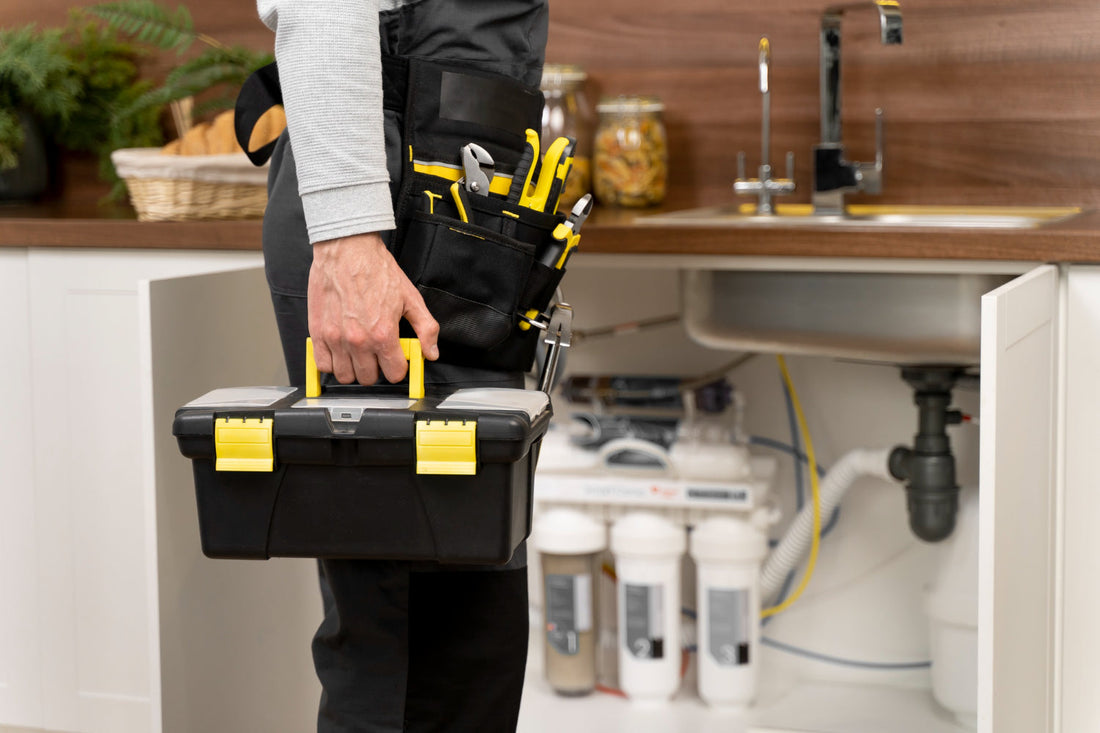
7 Plumbing Hacks Using Everyday Tools
Share
Plumbing is one of the most ignored maintenance tasks by homeowners. They do not think about it until something happens in the water supply or damages the main pipeline. And sometimes, the damage happens to this extent that even experienced plumbers might get caught up in the scenario when they have to make some smart improvisations using their common plumbing tools. These common improvisations help them to save time on the job and enhance their on-site efficiency.
What are these improvisations? Read the blog to know!
Plumbing Hacks to Know
Whether you are a seasoned plumber or managing a team of plumbing professionals, knowing how to use the common tools efficiently to solve on-site issues can give you an extra edge.
Hack #1: Use a Zip Tie to Fish Out Hair from Drains
Plumbers can use zip-ties to create a makeshift hair removal tool. Even if you do not have a drain snake in your plumbing toolkit to remove the clog inside the drain caused by hair, zip ties can effectively remove it unwanted hairs from the drain.
How to Do it?
Using a wire cutter, make small diagonal notches on both sides of the zip tie. Afterwards, gently bend each of the notches towards the outside to create bards. These bards will help to gather the mud and hair accumulated in the pathway of your sink. This can work effectively for bathroom sinks or tubs.
Once the zip tie is entirely down into the drain, slowly pull it out to extract the debris and hair that was clogging your drain. Continue to do it until water runs smoothly through the drain. Since both zip ties and wire cutters are common tools for plumbing, it will be effective to remove clogs in the drains. This is a great plumbing hack to do with limited resources.
Hack #2: Cleaning the Faucet Aerator with Vinegar Overnight
You can often experience the issue of low water pressure in your plumbing network. To fix it, you can do a couple of things. First of all, check the filters and valve in the sink. If it is clean, then the issue must be in the faucet aerator.
How to Do it?
To clean the faucet aerator, you have to slowly remove it from the faucet. Then, slowly soak it in vinegar overnight. The next morning, thoroughly rinse it and put it back together. You can see the improvement in the water pressure. Even if you do not have cleaners in your plumbing tools kit, the vinegar can help you do the job in the field.
Hack #3: Toothbrush for Cleaning Valve Seats
An old toothbrush can be effectively used to clean a faucet valve seat as the small, soft bristles can scrub the accumulated minerals away and remove the sediments in areas difficult to clean. If you do not have a valve seat dresser or a reseating tool basic plumbing tool kit, you can use a toothbrush as a handy option.
How to Do It?
First of all, the water supply should be turned off. After draining the faucet, remove the handles and cartridge located underneath the handles. You can locate the valve seat at the bottom of the faucet body.
Then, a cleaning solution can be prepared by mixing 50-50 of water and white vinegar. Then, scrub the area with the toothbrush by soaking it in the solution and scrubbing the interior wall to remove the sediment buildup. This can work well before applying thread sealant or replacing the washers of the faucet.
You can also use vinegar to lubricate the sticky valves. The vinegar will help to dissolve away any extra debris or residue buildup, which was causing the valve to be hardened.
Hack #4: Wet/Dry Vacuum for Unclogging Toilet
Unclogging a toilet can be a real hustle for new plumbers and house owners. Sometimes, plumbers do not have the right size of plungers as their specialty plumbing tools. If your toilet is still stuck after using hot water flushing, you can take your wet/dry vacuum.
How to Do it?
Simply suck up the extra water from the toilet bowl. This way, the suction can help dislodge whatever is the reason behind the blockage. After the clog is cleared, make sure you have flushed it properly to clean any remaining debris.
Hack #5: Duct Tape to Tighten the Pipe Fittings
Duct tape is an effective tool that can be handy in fixing loose plumbing fittings. A leaking pipe fitting can result in damaged plumbing settings and water damage to the floor and foundations. The leaky pipe fitting is something that can be easily repaired without needing new plumbing tools, as expert plumbers can do it with tools easily available in domestic settings.
How to Do It?
Use duct tape and wrap it around the nut, which has loosened up. Keep wrapping it around until the leak stops, and make sure you are wrapping the nuts tightly with the tape.
Hack #6: Fix Clogged Garbage Disposal
A clogged garbage disposal can spread foul smells and lead to an unhealthy environment in the house. Without having the basic plumbing tools, fixing the garbage clogging can become difficult and even impossible to unclog. However, using some easily available tools and materials, you can easily clear the clog in the garbage disposal.
How to Do It?
First, put some ice cubes down the drain, and run cold water to clear it out. After that, pour a mix of one cup of white vinegar and one cup of baking soda into the drain. This will help to remove the grease buildup inside the pipe and help garbage move through the drain smoothly.
Hack #7: Level a Toilet Using Metal Washers
Instead of plastic shims, a stack of metal washers can help level a rocking toilet temporarily. If you are toilet is not properly levelled on the ground, you can use this hack, even if you do not have plastic shims in your plumbing tools kit.
How to Do It?
Firstly, turn off the water supply and drain the toilet and the tank also. Gently push the toilet seat downwards to check whether it moves or rocks. Then, using basic pliers, tighten the nuts on the flange bolts placed underneath to seal any kind of gaps. Make sure you are not over-tightening it, as it can crack the porcelain base.
If the tightening does not work, you need to place the metal washers where the wobbling occurs. Adjust and lift the base to put it at the right level. Place as many washers as possible until the toilet seat is stable and does not rock anymore.
Finally, re-tighten the flange bolts to keep the shims in their appropriate place. To seal any gaps observed, you can apply caulk surrounding the base of the toilet.
Wrapping Up
There could be days when you are working in the field and you forget to bring the necessary plumbing tools. In these scenarios, smart work shows your readiness to do your work. On-field improvisations make you a smart plumber and show your efficiency.
Upgrade Your Toolkit and Replace Old Tools Frequently for Optimal Plumbing Performance
Ready to level up your toolbox with pro-grade gear? Upgrading the toolbox by replacing the older tools to elevate performance.
Frequently Asked Questions
1. What Can Cause a Sewer Smell in My House?
Ans. The uncomfortable sewer smell can be caused by dried U-trap or damaged sewer trap plugs.
2. If I Use Too Many Appliances With Low Water Pressure, Will It Harm the Performance?
Ans. Yes, using too many appliances with low water pressure can cause harm to the water supply.
3. Can I Use Lemon Peel to Reduce the Bad Odor?
Ans. Yes, lemon peel can be a good option to reduce the bad smell in the garbage drain.
